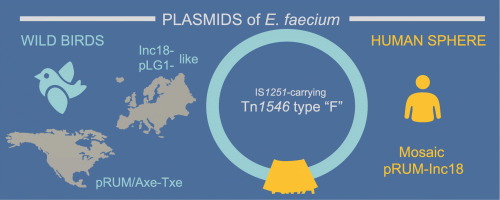Environment International ( IF 10.3 ) Pub Date : 2018-06-02 , DOI: 10.1016/j.envint.2018.05.039 Veronika Oravcová , Luísa Peixe , Teresa M. Coque , Carla Novais , Maria V. Francia , Ivan Literák , Ana R. Freitas

|
The most prevalent type of acquired vancomycin resistance in Enterococcus faecium (VREfm) is encoded by the vanA transposon Tn1546, mainly located on transferable plasmids. vanA plasmids have been characterized in VREfm from a variety of sources but not wild birds. The aim of this study was to analyse the genetic context of VREfm strains recovered from wild corvid birds and to compare their plasmid and strain characteristics with human strains. To achieve that, 75 VREfm isolates, including strains from wild birds recovered during wide surveillance studies performed in Europe, Canada and the United States (2010−2013), and clinical and wastewater strains from Czech Republic, a region lacking data about vanA plasmids, were analysed. Their population structure, presence of major putative virulence markers and characterization of vanA transposons and plasmids were established. VREfm from wild birds were mainly associated with major human lineages (ST18 and ST78) circulating in hospitals worldwide and were enriched in putative virulence markers that are highly associated with clinical E. faecium from human infections. They also carried plasmids of the same families usually found in the clinical setting [RCR, small theta plasmids, RepA_N (pRUM/pLG1) and Inc18]. The clinically widespread IS1251-carrying Tn1546 type “F” was predominant and Tn1546-vanA was mainly located on pRUM/Axe-Txe (USA) and Inc18- or pLG1-like (Europe) plasmids. VREfm from hospitals and wastewaters carried Tn1546-vanA in different plasmid types including mosaic pRUM-Inc18 plasmids, not identified in wild birds. This is the first characterization of vanA plasmids obtained from wild birds. A similar plasmid pool seems to exist in different clonal E. faecium backgrounds of humans and wild birds. The isolation of VREfm strains from wild birds that belong to human E. faecium adapted lineages and carry virulence genes, Tn1546 and plasmid variants widespread in the clinical setting is of concern and highlight their role as potential drivers of the global dissemination of vancomycin resistance.
中文翻译:

人源抗万古霉素粪便肠球菌定居的野生野生鸟类怀有流行的vanA质粒
粪肠球菌(VREfm)中最常见的获得性万古霉素耐药性由主要位于可转移质粒上的vanA转座子Tn 1546编码。在VREfm中已从多种来源(而非野生鸟类)中鉴定了vanA质粒。这项研究的目的是分析从野生Corvid鸟类中回收的VREfm菌株的遗传背景,并将它们的质粒和菌株特性与人类菌株进行比较。为了实现这一目标,有75种VREfm分离株,包括在欧洲,加拿大和美国(2010-2013年)进行的广泛监测研究期间从野生鸟类中分离得到的毒株,以及捷克共和国(缺乏vanA数据的地区)的临床和废水菌株。分析质粒。确定了它们的种群结构,主要推定毒力标记的存在以及vanA转座子和质粒的表征。来自野生鸟类的VREfm主要与世界各地医院中流传的主要人类谱系(ST18和ST78)相关,并富含与人类感染的临床屎肠球菌高度相关的推定毒力标记。他们还携带了通常在临床上发现的相同家族的质粒[RCR,小θ质粒,RepA_N(pRUM / pLG1)和Inc18]。临床上广泛使用IS 1251的Tn 1546型“ F”,而Tn 1546 - vanA质粒主要位于pRUM / Axe-Txe(美国)和Inc18或pLG1样(欧洲)质粒上。医院和废水中的VREfm携带Tn 1546 - vanA的不同质粒类型,包括未在野生鸟类中鉴定的镶嵌pRUM-Inc18质粒。这是从野生鸟类获得的vanA质粒的第一个特征。在人类和野生鸟类的不同克隆粪肠球菌背景中似乎存在相似的质粒库。从属于人类粪便大肠杆菌适应谱系并携带毒力基因的野生鸟类中分离出VREfm毒株,Tn 1546 在临床环境中普遍存在的质粒变体和质粒变体令人关注,并突显了它们作为全球传播万古霉素耐药性的潜在驱动力。











































 京公网安备 11010802027423号
京公网安备 11010802027423号